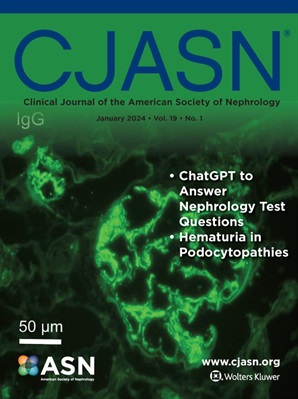维持性血液透析患者的用药负担与不良心血管事件和死亡:一项全国性队列研究
IF 7.1
1区 医学
Q1 UROLOGY & NEPHROLOGY
Clinical Journal of the American Society of Nephrology
Pub Date : 2024-09-20
DOI:10.2215/cjn.0000000000000570
引用次数: 0
摘要
目的:研究药物负担对接受维持性血液透析的终末期肾病患者不良预后的影响。方法 我们对 26,690 名接受维持性血液透析的患者进行了分析,这些患者参加了由健康保险审查和评估服务机构进行的定期血液透析质量评估。我们关注的暴露是常规处方口服药物的数量。主要结果是非致死性心血管事件(非致死性心肌梗死、冠状动脉血运重建、非致死性中风或因心力衰竭住院)或全因死亡(主要不良心脑血管事件)的复合结果。次要结果是主要结果的各个组成部分。结果 在 146,749 人年(中位数为 6.0 年)的随访期间,17,573 名患者(59.2%)发生了重大心脏和脑血管不良事件。用药负担越重,重大心脏和脑血管不良事件的发生率越高(在第一季度至第四季度,每千人年分别为 84.7、107.2、130.2 和 168.9 例)。在多变量考克斯比例危险模型中,与最低四分位数相比,第二、第三和最高四分位数的调整危险比(95% 置信区间)分别为 1.05(1.00-1.10)、1.12(1.07-1.17)和 1.27(1.21-1.33)。在连续模型中,药物数量每增加一种,主要结果的风险就增加 1.03 倍(95% 置信区间 1.03-1.04)。结论 在接受维持性血液透析的患者中,药物负担过重与不良心血管后果和全因死亡的风险较高密切相关。这些研究结果表明,高药物负担可能是血液透析患者不良临床结局的一个有用指标。版权所有 © 2024 年美国肾脏病学会...本文章由计算机程序翻译,如有差异,请以英文原文为准。
Medication Burden and Adverse Cardiovascular Events and Death in Patients Treated with Maintenance Hemodialysis: A Nationwide Cohort Study
ied to investigate the prognostic implications of medication burden regarding adverse outcomes in patients with end-stage kidney disease with maintenance hemodialysis. Methods We analyzed 26,690 patients receiving maintenance hemodialysis who participated in the Periodic Hemodialysis Quality Assessment conducted by the Health Insurance Review and Assessment Service. The exposure of interest was the number of routinely prescribed oral medications. The main outcome was a composite of non-fatal cardiovascular events (non-fatal myocardial infarction, coronary revascularization, non-fatal stroke, or hospitalization for heart failure) or all-cause death (major adverse cardiac and cerebrovascular events). The secondary outcomes were the individual components of the primary outcome. Results During a follow-up period of 146,749 person-years (median, 6.0 years), major adverse cardiac and cerebrovascular events occurred in 17,573 (59.2%) patients. Higher medication burden was associated with progressively higher incidence of major adverse cardiac and cerebrovascular events (84.7, 107.2, 130.2, and 168.9 events per 1000 person-years in Q1–Q4, respectively). In a multivariable Cox proportional hazard model, the adjusted hazard ratios (95% confidence intervals) for the second, third, and highest quartiles were 1.05 (1.00–1.10), 1.12 (1.07–1.17), and 1.27 (1.21–1.33), respectively, compared with the lowest quartile. In continuous modeling, each increase in the number of medication was associated with a 1.03-fold (95% confidence interval 1.03–1.04) higher risk of the primary outcome. Conclusion A high medication burden was independently associated with higher risk of adverse cardiovascular outcomes and all-cause death in patients receiving maintenance hemodialysis. These findings suggest that a high medication burden could be a useful indicator of adverse clinical outcomes in patients undergoing hemodialysis. Copyright © 2024 by the American Society of Nephrology...
求助全文
通过发布文献求助,成功后即可免费获取论文全文。
去求助
来源期刊
CiteScore
12.20
自引率
3.10%
发文量
514
审稿时长
3-6 weeks
期刊介绍:
The Clinical Journal of the American Society of Nephrology strives to establish itself as the foremost authority in communicating and influencing advances in clinical nephrology by (1) swiftly and effectively disseminating pivotal developments in clinical and translational research in nephrology, encompassing innovations in research methods and care delivery; (2) providing context for these advances in relation to future research directions and patient care; and (3) becoming a key voice on issues with potential implications for the clinical practice of nephrology, particularly within the United States. Original manuscript topics cover a range of areas, including Acid/Base and Electrolyte Disorders, Acute Kidney Injury and ICU Nephrology, Chronic Kidney Disease, Clinical Nephrology, Cystic Kidney Disease, Diabetes and the Kidney, Genetics, Geriatric and Palliative Nephrology, Glomerular and Tubulointerstitial Diseases, Hypertension, Maintenance Dialysis, Mineral Metabolism, Nephrolithiasis, and Transplantation.

 求助内容:
求助内容: 应助结果提醒方式:
应助结果提醒方式:


